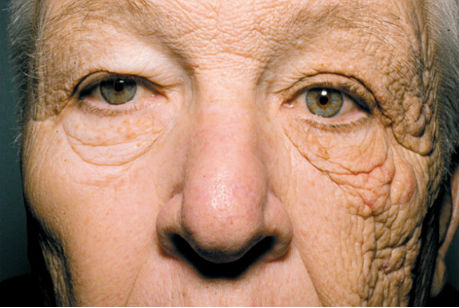I read this article..and I am myself spell bound..I knew sun ages..but was not aware of the extent..a must read..
To most people it’s a curiosity, something to laugh about with the kids: you spend a few hours a day driving and by mid-summer, your left hand and arm are shades darker than the right.
But as a new case presented in the New England Journal of Medicine shows, left-sided sun damage is no laughing matter. Over the years, that lopsided suntan and a few extra freckles can mutate into deep creases, sagging skin and a general look that’s far older than your true age—and, too often, a high risk of skin cancer.
What happened to this man’s face?
This man is a 69-year-old truck driver, making his living behind the wheel for the past 28 years. Half of his face looks normal for his age, but because he spent daytime hours with the sun to his left for nearly three decades, the left side of his face looks decades older.
The name for his condition is unilateral dermatoheliosis (one-sided photoaging). Driving with the sun beating down on his face and arm exposed the patient to damaging UVA rays for hours each day, just as if he had been lying on a beach with that skin exposed. Even with the window closed, UVA rays can penetrate window glass if not tinted enough to protect passengers inside the vehicle.
How dangerous is one-sided photoaging?
Sun worshippers pay a price for enjoying those drives in the sunshine, experts say. Researchers at the University of Washington studied cancer cases tracked by the U.S. government. Their findings, published in the American Academy of Dermatology, showed that when melanoma affected one side of a person’s body, it was on the left side—the driver’s side—52 percent of the time. Merkel cell cancers, another type of skin cancer, appeared on the left side in 53 percent of cases.
This isn’t the first evidence that motoring in the sun might be linked to skin cancer. A 2010 study of 1,047 skin cancer patients at the Saint Louis University School of Medicine, published in the same journal, came to the same conclusion: in both men and women, more skin cancers were found on the left side of the body than the right. And in Australia, where people drive on the right-hand side of the road, drivers’ right arms and right sides of their faces get the sun exposure. A 1986 study found that a majority of precancerous growths among Australian men occurred on their right sides.
Does tinted glass protect us?
Tinting window glass does afford some protection; compared to untinted glass, it admits 3.8 percent fewer UVA rays. The most protective color is gray, which admits only 0.9 percent of UVA light, compared to 62.8 percent of UVA light admitted through clear glass. (UVB rays don’t penetrate glass to a dangerous degree.)
But tinted glass can pose visibility issues. “People who are considering tinting their windows should take their car to a professional auto detailing shop, in order to ensure that the tinting meets the federally mandated 70 percent of minimum visible light transmittance through the windshield,” advises the American Academy of Dermatology. Auto glass tinting can be regulated by state law, and professional detailers will be aware of those guidelines.
How to Get Rid of a Tan
Stay safe with these tips!
In 2010, more than 68,000 new cases of melanoma were diagnosed in the U.S., according to the National Cancer Institute, and some 8,700 people died from it. Those aren’t the best odds; skin cancer is deadly. But short of tinting the glass in your car’s side windows, there are plenty of ways to protect yourself against one-sided skin damage:
Cover up. Rip a sleeve off of an old shirt and keep it in the car’s glove compartment; when you’re wearing short sleeves or a tank top, slip it over your arm.
Wear sunscreen on your face, neck and left arm when you’re driving. Some experts advise people to wear a thick, visible layer of sunscreen, rather than rubbing it into the skin. While that may be unrealistic if you are dressed for business or a nice lunch, do apply some sunscreen to vulnerable areas.
SPF 30 is your best bet. Sunscreen labeled SPF 30 provides 97 percent protection sun damage. Buying SPF 50 products, which often are pricier, isn’t necessary.
Forget sunning for vitamin D. Unprotected sun exposure isn’t safe, period. Take a vitamin D supplement and use sunscreen every time you’re outside, even on a cloudy day.
Don’t forget your shades! Americans don’t protect their eyes very well: a recent study found that 66 percent of us leave our sunglasses behind when we go to the beach, pool or parks, even on sunny days. Yet 17 percent of us get a cataract in at least one eye. Sunglasses lower the risk of getting cataracts.
Read the label on your sunscreen. A new report from the Environmental Working Group found that only 25 percent of 800 sunscreens they tested contained no potentially harmful chemicals. Another 25 percent contained retinyl palmitate, a form of vitamin A that actually can increase your cancer risk. But 94 brands, including those manufactured by CVS, Walgreens, Aveeno and Banana Boat, were found to be safe.
Photos courtesy of the New England Journal of Medicine.
Source: 1
I am sure we would not act lazy with our sunscreens now..I use the Neutrogena Ultra Sheer SPF 50 and Lotus ones..
Do you use a sunscreen every single day ?

One thought on “Evidence of Sun’s Aging Effect”
Comments are closed.